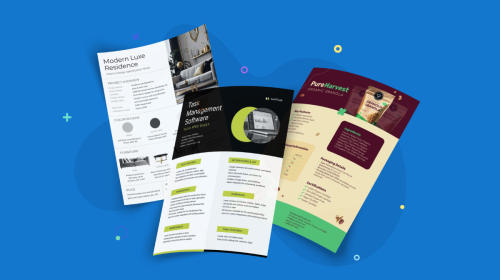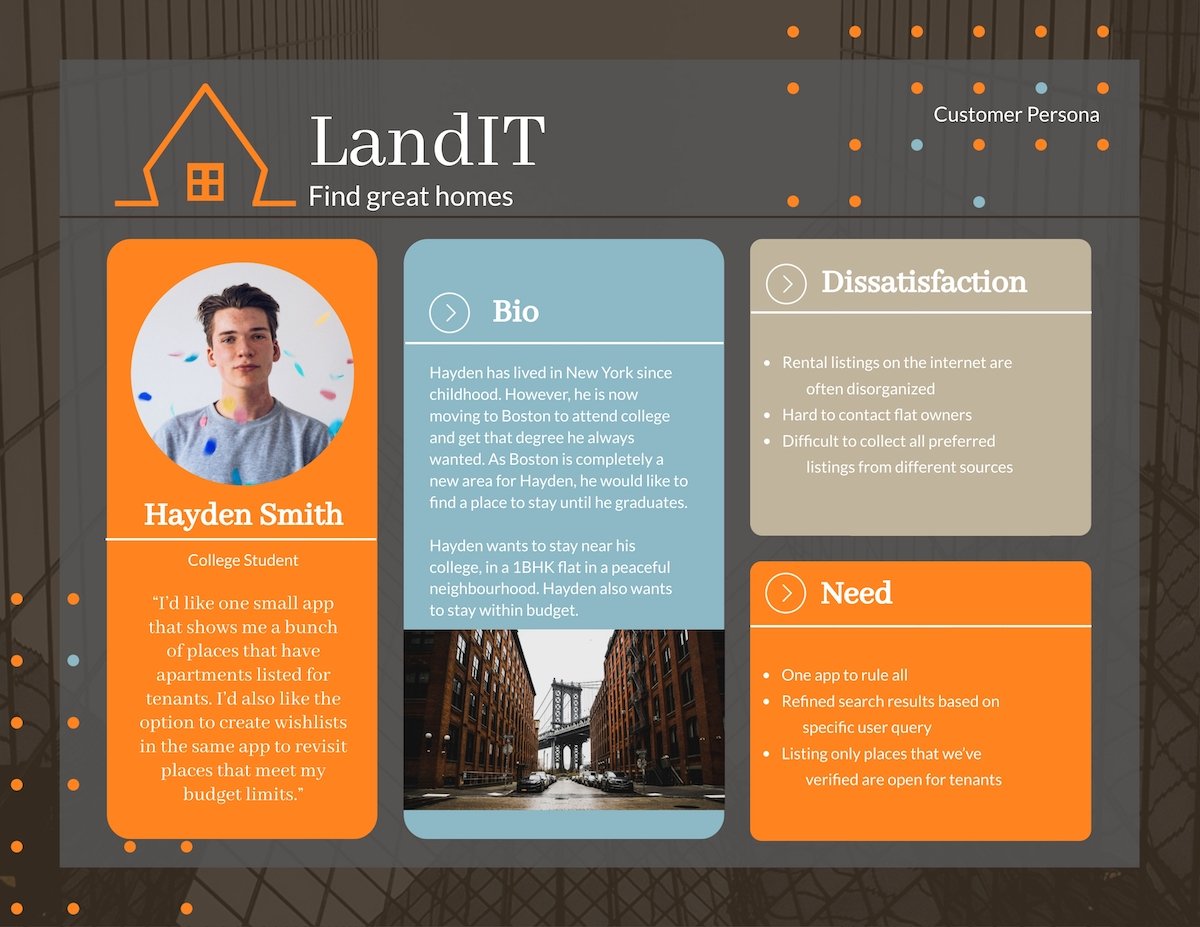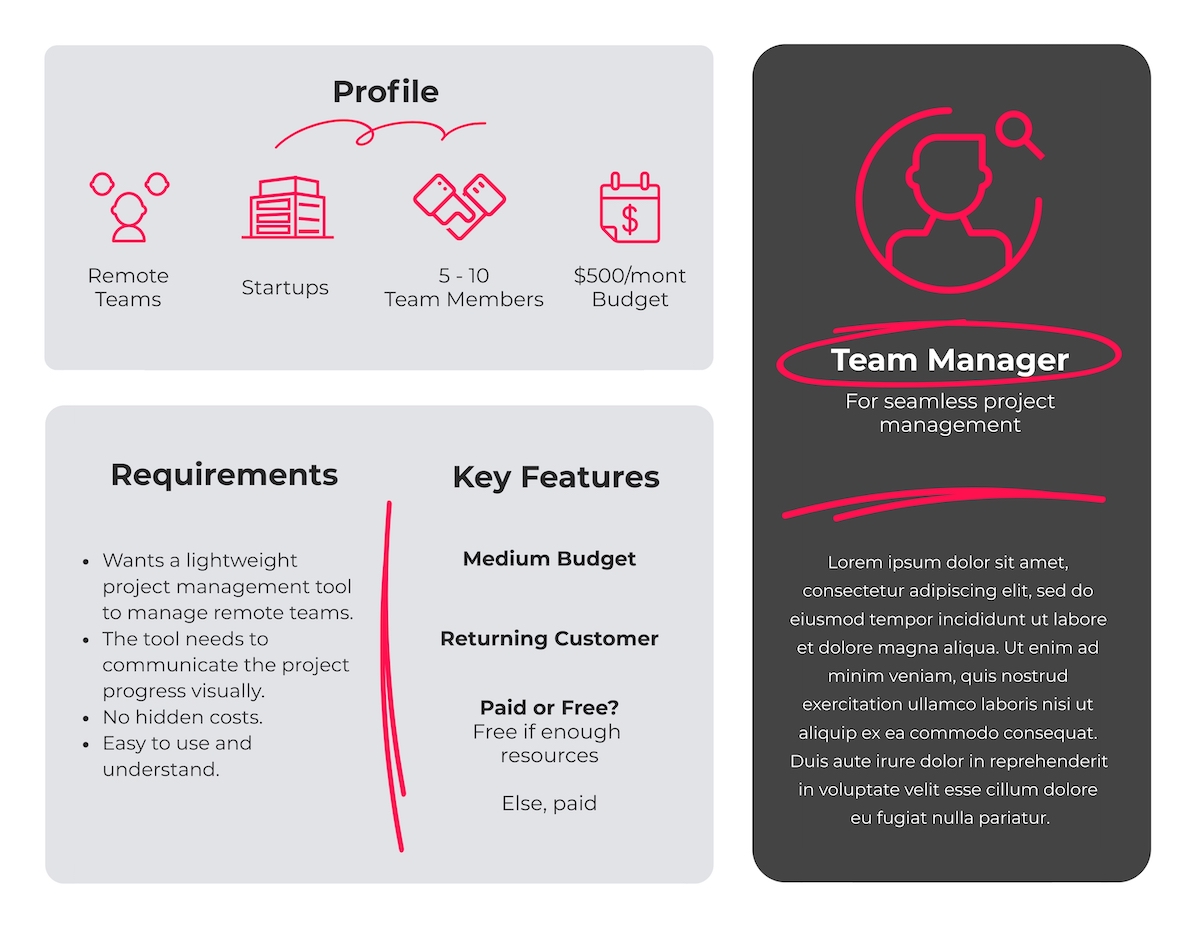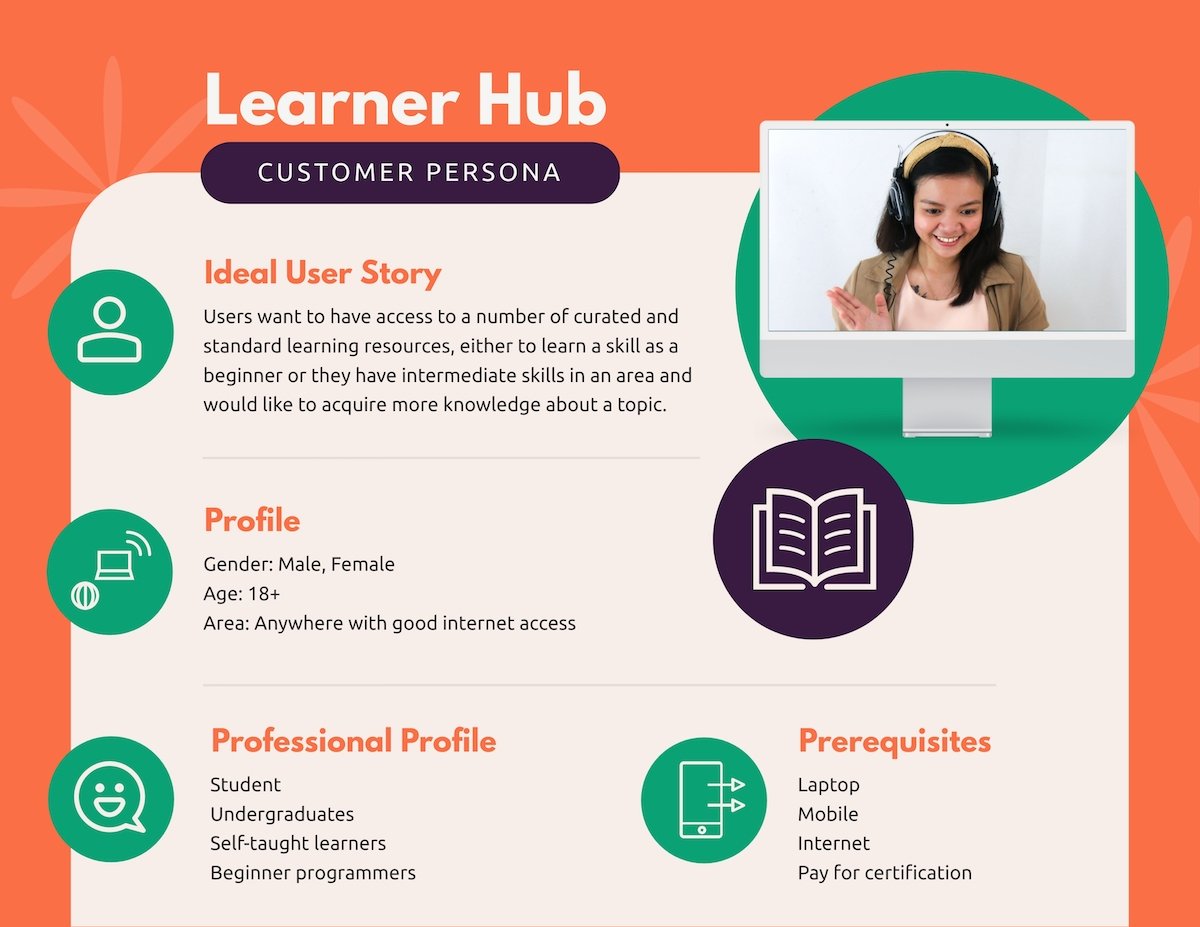
What is a User Persona and How to Create One


If you're a marketer, you've likely heard the term "user persona" before. But you might not know exactly what that is, why you need one and how you can create one.
That's what we're here for.
When businesses think of their audience as users instead of customers, their perspective shifts to providing solutions to the target audience’s pain points. Through this approach, your horizon also broadens outside of your current customer base.
So, how do you make sure your users are at the forefront of all your product designs? By creating a user persona. To get ahead of your customers, you have to give your users an unforgettable experience they can't get anywhere else — user personas help you with that.
Let's dive into what user personas are, what they include and how to create one.
A user persona is a fictional representation of your target customer whose goals represent the objectives of a larger group of users. A user persona is made from researching a target audience's needs, goals, behavior patterns, skills, and demographics.
Usually, a persona consists of a one or two-page document like the one shown below.

User personas help you understand your audience better. You can gain valuable insights and make better decisions to fulfill your users’ needs and expectations from your product.
To solve your users' problem with your product, you need to have a clear understanding of the problem, and you can easily gather this by knowing who your users are and what they need.
Knowing your audience enables you to choose better features and promote your product better, making your business more useful and accessible.
If you want to create something valuable that has ease of usability, you need to build a good user persona. Consider it your northern star — it guides you to make better business and marketing decisions from start to finish.
User persona helps you find the answer to a critical question, “Who are we marketing to?”
Let's have a look at how.
To build a product that's actually valuable for the people, empathy is your go-to resource. With a user persona, you can understand and empathize with the end-user by:
User personas can help marketers better understand the end of their prospects' journey, says Joanna, Marketing Strategist at Tiny Megaphone.
You sell a product to solve the user’s pain points. With a good user persona in place, you know exactly what solution to highlight to convince your audience that your product can solve their problem.
Ross Johnson, co-founder of 37designs says that you can't have an effective marketing strategy without a good user persona in place. “Personas allow you to focus your strategic decisions around your understanding of your target audience. Instead of saying, "Do we like this approach?" you start asking questions like, "How would Persona A respond to this?"
Having a user persona makes it so everyone in the company — marketers, stakeholders, designers, writers and more — are on the same page about who they're marketing to, designing for or writing about.
It's easy to add a set of user characteristics together and call it user persona but it is challenging to create personas that are truly effective. A basic user persona answers the following questions:
So a well-defined user persona encapsulates all the needs and expectations of your users efficiently while bringing life to the individuals who use your product. Let's have a look at everything you should include in your user persona.
Start your user persona with the basic information about your user like:
With this information in hand, you can quickly get a quick snapshot of who they are.

I mentioned archetype above and it's important to know that with a user persona it's not possible to present information about every single one of your users. So, with the data in hand, you try to put together an archetype of a typical user.
Let's look at an example. If your target audience is using mobile phones on the go, you might call them the “The Busy Browser.”
If you are targeting an older audience, you might nickname them “The Grandpas.” You can choose whatever as long as it captures your specific archetype.
We've all heard of the phrase, “A picture tells a thousand words,” and it's on point. With an image, you can tell a bigger story than any amount of words can. Adding a picture also humanizes your user persona and gives you a better idea of how your design can impact this person’s life.
Add a picture that encapsulates your users’ age, gender, and personality. Are they a suit-and-tie C-suite executive? Or are they more of a wearing scarf sitting in a coffee shop working on their laptop?

Describing the personality of your user persona helps you really understand who they are and make the best marketing decisions for yourbrand. You can:

In this section, you mention all that's motivating your user persona right now. Why would they be drawn towards your product and what do they need from your product? By finding out their goals and motivations, you can determine how your brand can serve their motivations.

In marketing, your target users’ pain points are one of the most important factors influencing your content and campaigns.
Make a point of what they're struggling with and how your product will help solve these issues for them. By finding these pain points and frustrations, you are better equipped to explain how your product provides them with what they're looking for.

So far we've covered what a user persona includes. Let's move on to the process of creating a user persona. You can create user personas through research, surveys, interviews — with a mix of customers, prospects, and your target audience.
Let's have a look at the five steps you need to follow to create a user persona effectively.
Let's start with the basics — what to ask your target audience and where to find them.
The most accurate user personas are based on actual field research. You can gather information from in-depth user interviews and observation data of real users.
Suppose you have time and monetary restraints to conduct research and your product is available on the market. In that case, you can get data from customer support logs and web analytics to create a user persona.
Unsure about where to find people to interview? Let's have a look at the people you can reach out to for your research.
The best people to interview are your current customers because they have already purchased and used your product and are familiar with your company. Don't just limit yourselves to people who love your product. Talk to people who are unhappy with your product as they will show you issues you may have missed.
Reach out to people who haven't used your product and don't know much about your company. Use the data you have on them (from lead generation forms or website analytics) and determine who fits into your target personas and reach out to them.
If you don't have any leads or customers yet, you can rely on referrals to talk to your target audience. How? Use your network — coworkers, existing customers, social media contacts — and find people who are willing to talk to you.
According to Amanda Leek, Content Marketing Consultant at Pounce, you can find conversations on all social media channels with real, identifiable names such as Linkedin, Facebook, YouTube, Instagram. These platforms help you find sources to find your target audience and initiate conversations with them.
After identifying your target audience, you have to start collecting data and you can do so by
Now that you've gathered the data from your research and surveys, it's time to analyze it. During this step, the goal is to find patterns in the data you have collected and group similar people together into types of users.
List down all the behavioral variables — these can be benefits sought, user status, usage rate, loyalty status and buyer readiness stage. Map each interviewee against the appropriate set of variables. This way, you can identify trends and make groups.
These groups will then form the basis of each persona.
When analyzing the data collected, you will notice that there are different groups within your target audience — so only one user persona isn't going to cut it. So how many personas should you actually create?
It depends on the range of the data collected and the depth of user research. Generally you should create anywhere from 3 to 5 user personas.
Most businesses have a target audience with attributes that fall under a subset of 3 to 5 primary personas. Having any more will make the whole process unnecessarily complicated, leading to a lack of focus and a creative process that's all over the place.
Remember to be consistent with your user personas so you can quickly compare and contrast between different personas. Take a look at this example below with two personas.

At this point, you know your data like the back of your hand and you have an idea of how your user personas break down in reality. So it's time you start to shape them into distinct personas based on their behavioral patterns.
You can also put together all your personas so the details are comparable yet you can differentiate between them easily.

Describe each persona by adding enough details to make them understandable and empathetic to the people involved in the design process. With all the data in hand, here is how you make a persona:
Your header includes a fictional name, image, and a small summary that includes what matters the most to this persona in relation to your product. Let's suppose you are designing a social media management app. The header of your user persona could look like this:
Name: Kaley Brown
Summary quote: “Let’s me post, schedule, and manage my social media with ease-of-use without additional steps.”
With these steps, you make your user persona memorable, keeping the design team focused on who they are designing for.
Now that you've named your user persona, it's time to fill in demographics like personal background, professional details, user environment and psychographics.
Personal background
Personal background includes things like age, gender, ethnicity, education, family status.
Continuing our example of Kaley, her personal background can be: Kaley, 43 years old, married, mother of a girl and a boy, has a Master's degree in Marketing.
Professional background
Professional background includes details such as job occupation, income level, and work experience. Kaley works as a Social Media Manager at a Fortune 500 firm and earns around $100k per year.
The following example of a user persona has a detailed background including age, income and location. It also details the persona’s current feelings and lets the designers know about the persona’s headspace.
User environment
User environment can answer questions like:
In Kaley's case, she spends most of her time in office on her Mac and iPad and collaborates with her team regularly.
Psychographics
This section includes details like attitudes, interests, pain points and goals. Creating a psychographic profile lets marketers better understand why the user persona behaves in a certain way, including why they use/would use your product.
If we continue with our social media management app, the useful psychographic information to add in this section could be — Kaley hates apps that keep crashing in the middle of her social posts scheduling, appreciates an element of ease-of-use and fuss-free approach to community management, and prefers to have a cleaner UI/UX.
Overall, the demographic section adds an additional layer of realism to the user persona — amplifying empathy while exploring user needs and goals.
The end goal basically answers the question — what do users need or want to accomplish by using your product. End goals or motivations are the main driving forces of your users.
In the case of Kaley, her end goal when using your social media management is to have a seamless experience and schedule her social media posts without going jumping through a lot of hoops.
This section is basically a “day-in-the-life” description that showcases how a user persona would interact with your product to achieve their end goals. With Kaley, her scenario could sound like this:
“As a social media manager, I have to schedule posts, remain on top of different social media platforms, and do community management. As a manager, I have other things to take care of so with my social media management app, I like to have user-friendliness and accessibility at the core.”
You can also add additional information like social media channels, website, and even browsers they use on a regular basis. You can also include their favorite brands, books, tv shows, etc.
If you've talked to any of your target audience, you can add a direct quote from them as well. One important thing to note here is that you should only stick to data that's productive and helpful in making design decisions.
With all these included in the document, your user persona is ready to go.

We've covered almost everything — what is a user persona, what constitutes a good user persona and how do you create one.
So, where do you get started? With Visme!
Visme gives you access to 50+ user persona templates. Sign up for a free Visme account to create engaging user personas. With easy-to-use, fully customizable capabilities, you can take control of how your user persona looks and feels to make it more captivating and responsive.
Design visual brand experiences for your business whether you are a seasoned designer or a total novice.
Try Visme for free